| Home | What we do | What's on | Yarra Pygmy Perch | Our History | FAQ | Resources | Things to see | Photo Gallery | Contact Us |
|---|

Further to the report WAURN PONDS CREEK FLORA SURVEY AND REVEGETATION OUTLINE (May 2002), the following sets out in more detail recommendations on revegetation of three sites along the valley viz
This report describes the appearance and floristic structure anticipated from the plantings, lists and describes the plant species, comments on faunal values, and recommends spacings for each species.
Revegetation of the Waurn Ponds Creek valley would seem to have several primary objectives.
The formation of a Friends of Waurn Ponds Creek, the involvement of service clubs and schools, local resident groups and individuals, all with active Council support, has already gone a long way to achieving the 'ownership" component.
No doubt it will continue into the future, as it will need to do if the valley is to be adequately maintained as the vegetation matures.
Some research into the faunal values has been undertaken, resulting in the discovery of a population of the rare Yarra Pygmy Perch.
A large amount of woody weed removal has taken place, and the installation of litter traps in the future will lead to enhanced water quality.
Development of housing on sections of the lower catchment of the creek will lead to increased runoff from paved areas, and this may cause local, short-term flooding in periods of intense rainfall.
The dominant plants are eucalypts and sheoaks with several species of wattle.
The overall appearance being sought could be called park-like, with trees providing an open canopy, some copses of wattles, mainly mown grass, with tussocks and ground-cover plants beneath the copses but not widespread.
This is on the more elevated land, and could be the site for formal paths, seats, picnic tables and children's playgrounds.
Its faunal value would be by providing tall trees, as well as open areas for ground-feeding birds.
Among the wattle copses there should be some prickly plants to provide secure nesting places for wrens, finches and other small birds. This is important because cats will inevitably prowl from local dwellings.
The eucalypts recommended are Manna and Yellow Gums. Because of the gradual rising elevation along the valley, it is suggested that Manna Gums should predominate on the lower reaches while Yellow Gums should do so on the upstream section.
Drooping Sheoaks should be confined to this zone, and they should increase in number higher up the catchment.
The wattles suggested are Golden and Black Wattles, with Lightwood on the upper sections. Some Hedge Wattle, or Prickly Moses Wattle, should be used as bird habitat.
Most of the ground-cover plants in un-mowed areas should be Tussock Grass, with some Small-leaf Clematis, Twiggy Daisy-bush and other low-growing shrubs among them, beneath a closed canopy of wattles.
Trees should include River Red Gum as the dominant species, with some Swamp Gums on the lower areas.
Blackwood and Black Wattles would be the main wattle species. The trees will form a mostly-closed canopy.
Tussock Grass and some riparian shrubs (see zone 3) should be included in the boggy areas.
Most of the flood-plain can be maintained by mowing, however copses of grass and shrubs should extend out from the riparian zone wherever possible.
At strategic places, at view-points for example, seats could be sited, however there should be a minimum of formal paths in the flood-plain zone.
Wildlife habitat will exist in the trees, and in the copses extending off the riparian planting.
Although a relatively narrow strip of vegetation, it has the potential to contain the widest diversity of plant species.
With River Red Gum, Blackwood and Silver Wattle as dominants, there will be Woolly Teatree, River Bottlebrush, Hempbush, Hop Goodenia and other shrubs. The existing reed-beds are important and should not be over-planted with shrubs.
Faunal values are in a wide range of birds which make use of the riparian areas, and in the vegetation which will shade the water in the creek.
These exist in several sites. There is little need to undertake planting, however some Water Ribbons and Variable Groundsel may enhance the appearance.
Wetlands are important for fauna, and may need to be screened with riparian plantings to protect birdlife in particular from disturbance.
Planting will depend on whether there is open water (as at Winter Street) or boggy drainage lines. Plants should include Water Ribbons, sedges and Tussock Grass.
A comprehensive list of plants recommended for planting along Waurn ponds Creek can be found here.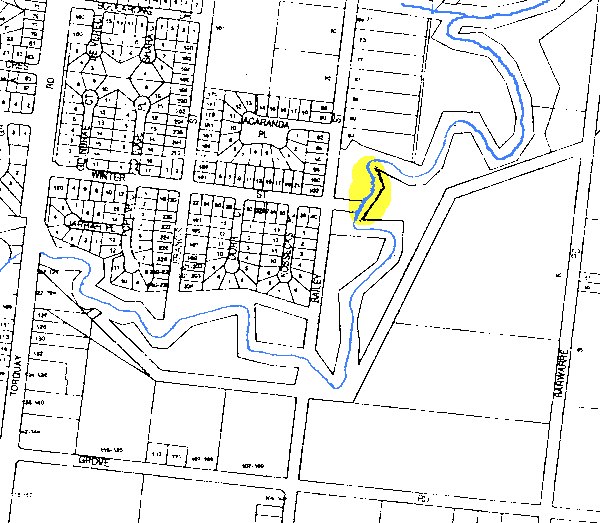
This section extends from the rear of the housing "village" to Bailey Street, opposite Winter Street. Some planting has been undertaken already, and the following comments refer mainly to the land between the creek and the sewer-main and on the east side of it.
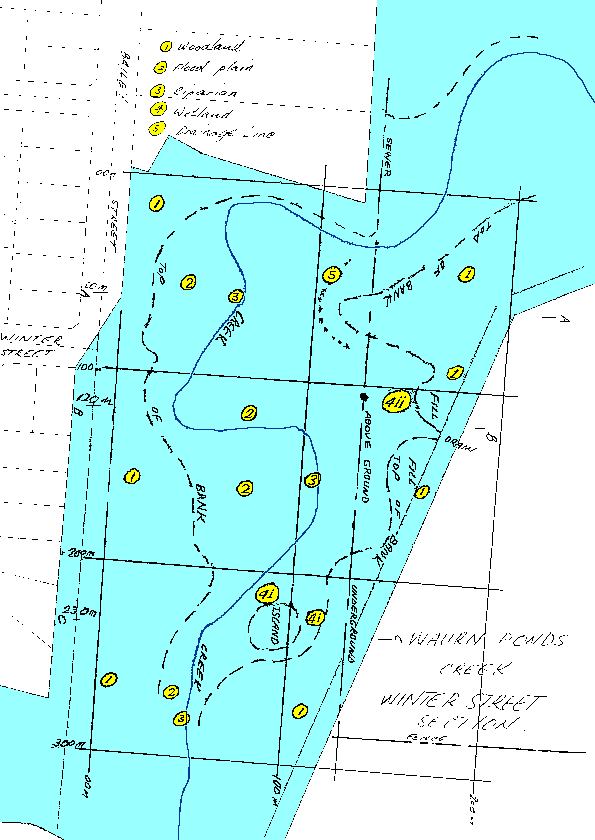
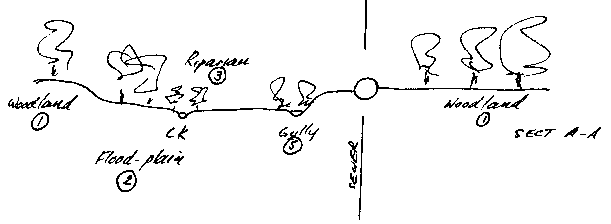
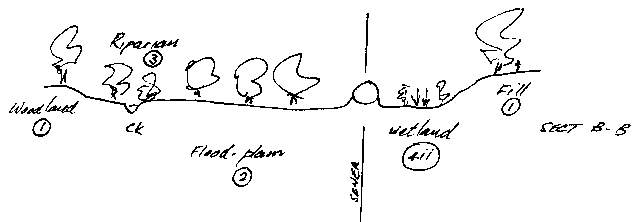
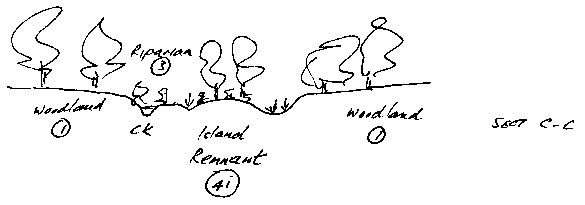
Species and spacing-
| Manna Gum Yellow Gum Drooping Sheoak Black Wattle Golden Wattle |
scattered scattered scattered copses copses |
3-10m, canopy 3-10m, canopy (few only) 3-10m, canopy 2-4m small tree 2-5m, small tree |
| Tussock Grass | copses | mulched, with Gold-dust Wattle, Common Everlasting, Black-anther Flax-lily, Twiggy Daisy-bush, Austral Storks-bill, Smooth Rice-flower, Branching Groundsel and New Holland Daisy as ground-cover. |
Some planting has been undertaken here, however some additions could be made.
| Silver Wattle Golden Wattle Tree Everlasting |
scattered scattered scattered |
3-5m, canopy 2-5m, small tree 1-3m, shrub |
The riparian strip in this section is narrow, however the plantings can be broadened on the inside of the creek bends on the west side, to complement the flood-plain planting.
Species and spacing.
| River Red Gum Silver Wattle Blackwood River Bottlebrush Prickly Currant-bush Hop Goodenia Hemp Bush Woolly Teatree Kangaroo Apple | scattered scattered scattered scattered copse copse scattered scattered scattered | 3-10m, canopy 3-5m, canopy 3-5m, canopy 1-3m, shrub 1-3m, shrub 1-3m, shrub 1-3m, shrub 1-3m, shrub 2-5m, shrub |
Several wetlands exist on the east side of the creek, notably around a small island and at the outlet of the drain that runs from the 'village'.
There are several River Red Gums on the edge of the island, and some Kangaroo Grass and saltbush remain. Selective weed removal from the island and the bank on the north side (where Kangaroo Grass exists), and careful replanting with the following species could greatly enhance this remnant.
| River Red Gum Silver Wattle Berry Saltbush Austral Storks-bill Smooth Rice-flower Kangaroo Grass New Holland Daisy |
scattered scattered copse copse copse copse copse |
3-10m, canopy 3-5m, canopy 1-2m, shrub 1-2m, ground-cover 0.5-1m, ground-cover 0.5-1m, tussock 0.5 -1m, ground-cover |
In the drainage channel, around the island, some minor planting may be appropriate.
| Spiny-headed Mat-rush Variable Groundsel Water Ribbons |
copse scattered scattered |
0.5-1m, tussock 2-5m, shrub 1-2m, tussock |
An ephemeral wetland with some sedges existing, it could be enhanced by planting.
| Tall Spike-rush Variable Groundsel |
scattered scattered |
1-3m, tussock 2-5m, shrub |
On the adjacent banks, riparian plants should be appropriate.
This may have been part of the creek flood-overflow, before the sewer-main was constructed. It contains some water and it would be enhanced with planting.
| Tall Spike-rush Purple Loosestrife Variable Groundsel Water Ribbons |
scattered scattered scattered scattered |
1-3m, tussock 1-2m, herb 2-5m, shrub 2-5m, tussock |
The adjacent land is part of the flood-plain and should be planted with the species as under zone 2 above.
Riparian plantings (zone 3) should be undertaken on the inside of the creek bend.
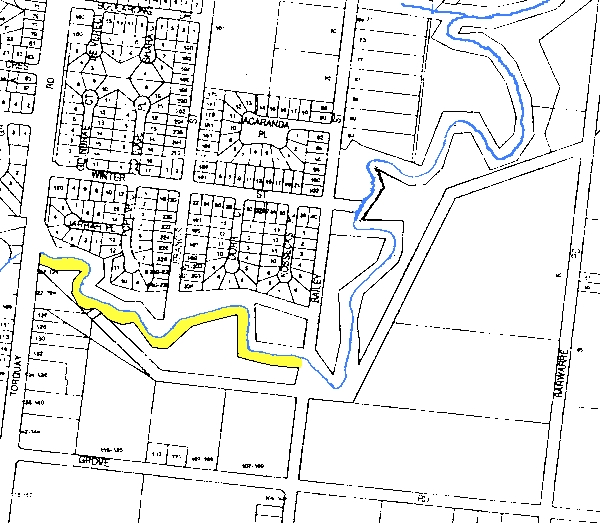
The section has several remnant River Red Gums and a patch of Tussock Grass, but it is generally clear of indigenous vegetation. A dense infestation of broom has been cleared. There is one mature Sugar Gum, and a small one adjacent to it presumably self-sown. Most of the land is elevated and well suited to revegetation into a woodland containing a number of copses of shrubs, ground-cover plants and tussocks.
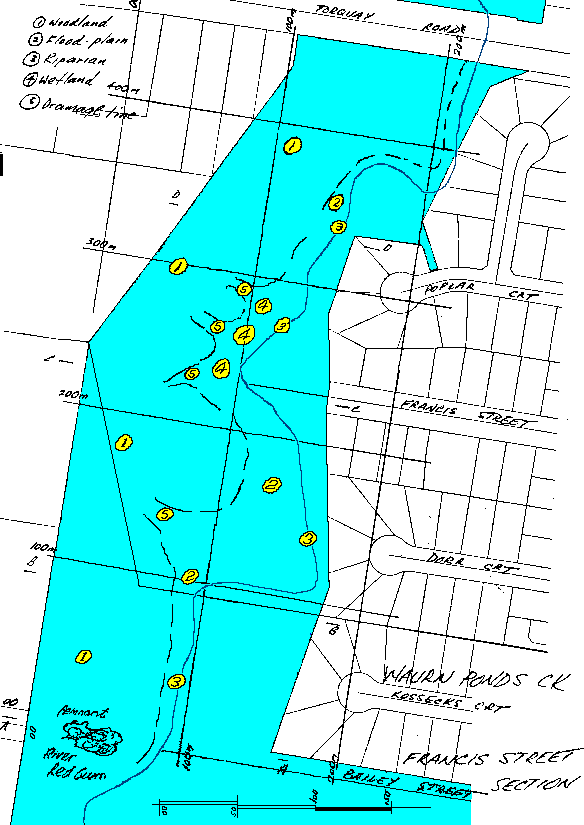
Four minor drainage lines enter the creek, one roughly opposite Dorr Court while the others are close together and opposite, and just west of, the Francis Street extension. The latter group lend themselves to revegetation as a small wetland complex.
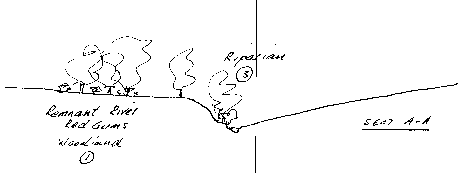

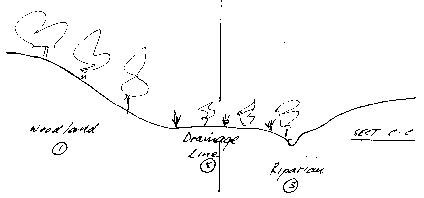
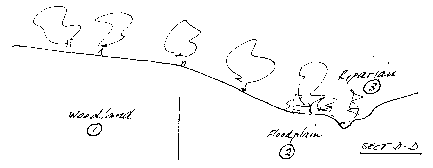
The majority of the site is rising land well above the creek.
Species and spacing.
| Manna Gum Yellow Gum Drooping Sheoak Blackwood Golden Wattle |
scattered scattered scattered scattered small copses and scattered |
3-10m, canopy 3-10m, canopy 3-10m, canopy mainly on higher ground 3-5m, canopy mainly closer to creek 2-5M small tree |
| Black Wattle | copses | 10m wide, mulched, with an understorey of Tussock Grass, Black-anther Flax-lily, Twiggy Daisy-bush, Austral Storks-bill, Smooth Rice-flower, Gold-dust Wattle, New Holland Daisy. |
A smaller area, mainly in the bend of the creek opposite Dorr Court
Species and spacing.
| River Red Gum Swamp Gum Silver Wattle Hop Goodenia Hemp Bush Tree Everlasting Woolly Teatree Kangaroo Apple |
scattered scattered scattered scattered scattered scattered scattered scattered |
3-10m, canopy 3-10m, canopy 3-5m, canopy 1-3m, shrub 1-3m, shrub 1-3m, shrub 1-3m, shrub 1-3m, shrub |
Narrow corridor along the bank of the creek.
Species and spacing.
| River Red Gum Blackwood Silver Wattle Prickly Moses River Bottlebrush Hop Goodenia Hemp Bush Woolly Teatree Spiny-headed Mat-rush Tussock Grass |
scattered scattered scattered scattered scattered scattered scattered scattered |
3-10m, canopy 3-5m, canopy 3-5m, canopy 2-3m, shrub 1-3m, shrub 1-3m, shrub 1-3m, shrub 1-3m, shrub 0.5-1m, tussock 0.5-10m, tussock |
Only at the lower ends of the drainage lines.
Species and spacing.
| Tall Spike-rush Purple Loosestrife Variable Groundsel Water Ribbons |
scattered scattered scattered scattered |
1-3m, tussock 1-2m, herb 2-5m shrub 1-2m tussock, close to creek |
Planting of riparian species along the margins will connect the two zones so that there is no sudden change.
Mainly riparian species, with an emphasis on the shrubs, all scattered at 1-3m spacing.
| River Bottlebrush Hop Goodenia Hemp Bush Woolly Teatree Tussock Grass |
copses | 0.5-1m, tussock |
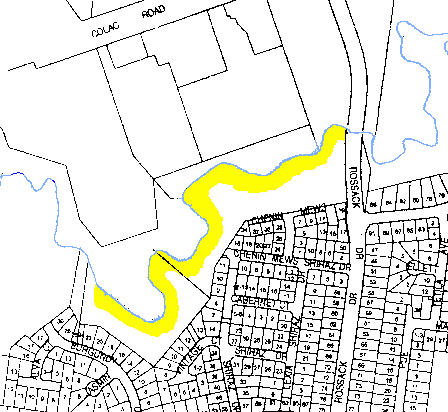
The relatively flat nature of the land above the creek lends itself to woodland planting, a major feature of which should be to provide some visual screening of the new commercial buildings on the north bank.
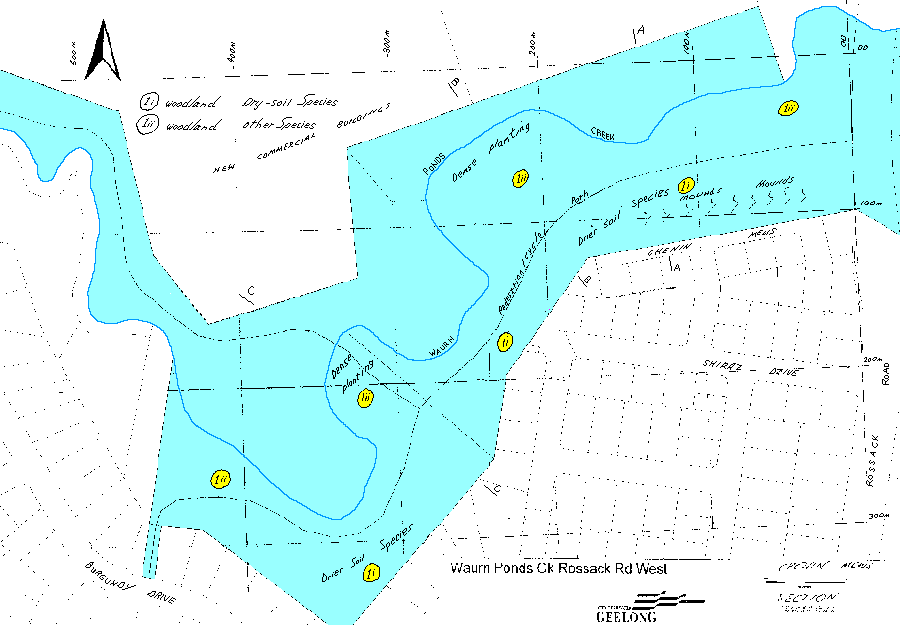
While the densest plantings may be most appropriate for the north bank, there are two sites on inside bends of the creek on the south where the trees should be closely spaced without losing the woodland character.
A number of plantings have been undertaken to develop copses of vegetation, and most of the plants are consistent with those on the woodland list. Any that may be considered woody weeds should be removed, and the plantings enhanced with Tussock Grass, ground-cover species, and canopy trees.
There are several landscape mounds between the pedestrian/cycle path and Chenin Mews houses, but these can be used as the site for Yellow Gum, Drooping Sheoak and other drier-soil species.
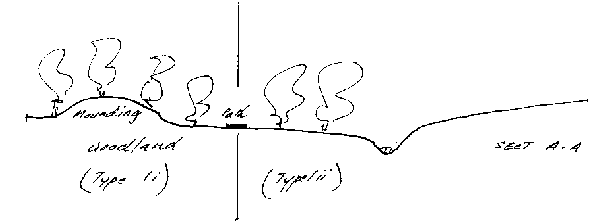

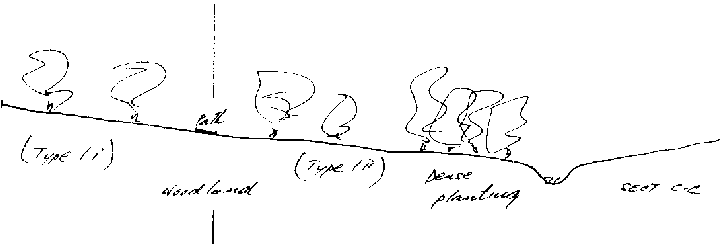
To provide some species diversity in the planting, the site has been roughly divided into two woodland zones as follows.
Use drier-soil plants here viz
| Yellow Gum Sheoak Lightwood Black Wattle Silver Banksia Sweet Bursaria Hop Bush Shrub Violet Twiggy Daisy-bush Pomaderris Common Everlasting Austral Storks-bill Smooth Rice-flower New Holland Daisy Tussock Grass |
scattered scattered copses copses scattered scattered scattered scattered copses scattered copses copses copses copses copses |
3-10m, canopy 3-10m, canopy 3-5m, small tree 2-4m, small tree 2-5m, small tree 2-5m, small tree 1-3m, shrub 1-3m, shrub 1-2m, small shrub 2-5m, shrub 0.5-1m, ground-cover 1-2m, ground-cover 0.5-1m, ground-cover 0.5-1m ground-cover 0.5-lm, tussock |
| River Red Gum Manna Gum Black-wood Black Wattle Golden Wattle Prickly Moses Hop Goodenia Sticky Boobialia Seaberry Saltbush Branching Groundsel Kangaroo Apple Tussock Grass |
scattered scattered scattered scattered copses copses copses copses copses copses copses copses |
3-10m, creek bank 3-10m, canopy 3-5m, canopy 2-4m, tree 2-5m, small tree 2-3m, small tree 1-3m, shrub 1-3m, shrub 1-2m, shrub 2-5m, shrub 2-5m, shrub 0.5-1m, tussock |
There is little opportunity for this zone.
Due to the need for bank restoration, planting along the creek margins seem inappropriate.